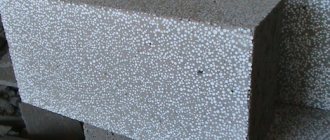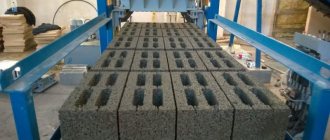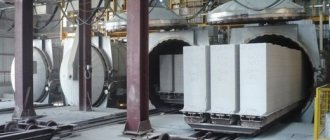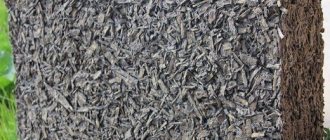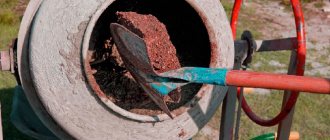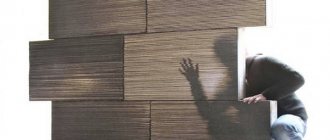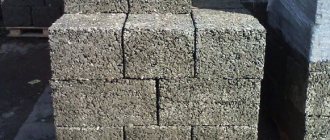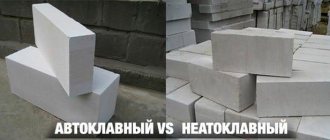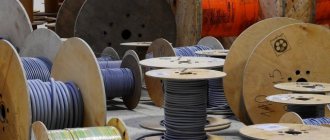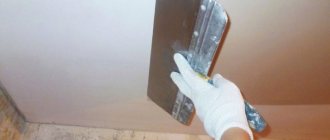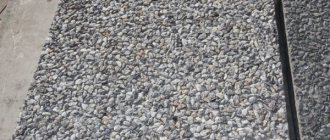Production of polystyrene concrete
The construction industry does not stand still. Every year more and more new modern materials appear that can seriously compete with already established products on the market. One can confidently call this polystyrene concrete, which, having demonstrated the effectiveness of its technical qualities, has taken a strong position among the leaders.
Due to the growing popularity among developers, the idea of setting up the production of such products has attracted the interest of many potential entrepreneurs and other representatives of small and medium-sized businesses. After all, the costs required for this are small, and the result can bring good profits.
In this article we will consider the features of the release of this material. So: the technology for producing polystyrene concrete - what it is, and how profitable the business can be.
Briefly about polystyrene concrete: composition and properties of the material
To successfully start production, in addition to organizational issues, you must first become familiar with the characteristics of the material and the composition of the raw materials. Agree, it would be stupid to release something you know nothing about.
Structure of polystyrene concrete
So, polystyrene concrete is a representative of lightweight concrete. It is distinguished by the presence of polystyrene and concrete crumbs in its composition, as well as specialized additives that increase the characteristics of the mixture and products made from it.
Polystyrene concrete blocks: composition
The polystyrene fraction can be different; it varies mainly depending on the desired density. The dependence is simple: the more polystyrene, the lighter the block, and its heat-saving ability is higher.
Polystyrene concrete crumbs
Let's move on to the main features:
- Like other types of lightweight concrete, depending on the average density, polystyrene products can be used as a thermal insulation or structural material. This figure can vary from 150 to 600 kg/m3.
- The thermal conductivity of the dry material begins to count from a numerical value of 0.05. In this regard, polystyrene concrete can be said to be a leader. The maximum value does not exceed 0.145.
Thermal conductivity and vapor permeability of polystyrene concrete
The finished structure, built using polystyrene concrete, will, of course, have a high coefficient - due to being in a state of operational humidity. However, there will be no significant changes.
Comparison of the heat-saving characteristics of polystyrene concrete with other materials
- Polystyrene concrete is characterized by a high frost resistance grade - it can reach 200. This means that the products can withstand up to 200 cycles of temporary freezing and thawing.
- It is also worth noting that polystyrene concrete is an environmentally friendly material; it does not burn. However, it is not able to withstand high temperatures for a long time.
- The durability of the products leaves no doubt. Much depends on the manufacturer, operating conditions, composition of raw materials and technically correct finishing. However, if all standards are met, polystyrene concrete will last an extremely long time.
Polystyrene concrete takes a leading position in durability
- The strength grade is directly dependent on the density. The minimum value established by GOST is B 0.35.
Technical properties of polystyrene concrete:
| Indicator name | Meaning |
| Thermal conductivity coefficient, W*mS | 0,05-0,145 |
| Average density, kg/m3 | 150-600 |
| Strength grade, B | 0,35-5 |
| Frost resistance, cycles | 25-200 |
| Shrinkage | Up to 1 mm/m2 |
| Water absorption | 5-8% |
Business Plan for the production of polystyrene concrete blocks
Home \ Business plans \ Business plan for the production of polystyrene concrete blocksEconomic efficiency of production of polystyrene concrete blocks using the Automated Line SGS-L5 Polystyrene.
General information.
Today, when so much attention is paid to the environment, the production of environmentally friendly and at the same time warm, light, high-quality and reliable materials is very relevant and in demand, so we have developed a technology for the production of polystyrene concrete blocks using SGS equipment.
Polystyrene concrete blocks are well known and widely used abroad. They are highly valued for their energy- and heat-saving, sound-absorbing properties.
These materials are used to build not only private houses, but even high-rise and industrial buildings.
Properties of Polystyrene concrete blocks:
The main dimensions of polystyrene concrete blocks are 200*300*600 mm, 150*300*600 mm, 100*300*600 mm, 200*300*500 mm, 150*300*500mm, 100*300*500mm, 190*190*390mm, 100*190*390mm.
- Versatility . You can build houses, cottages, and bathhouses from polystyrene concrete blocks. Polystyrene concrete blocks can be used in the construction of buildings throughout Russia.
- Environmental friendliness . Polystyrene concrete blocks combine the best advantages of polystyrene and the strength of concrete. A house made of polystyrene concrete blocks is safe for human health and the natural environment.
- Thermal conductivity . The thermal insulation performance of polystyrene concrete blocks is 3 times better than that of expanded clay concrete, and 6 times better than that of brick. Thermal conductivity coefficient is in the range from 0.55 to 0.12 W/m.
- Durability . If the load exceeds the maximum permissible, cracking of polystyrene concrete blocks does not occur (this problem is typical for foam blocks, bricks and aerated concrete blocks). The strength grade of polystyrene concrete blocks is from M7.5 to M50.
- Soundproofing . Good noise-absorbing and sound-insulating properties of the material (for a wall 100 mm - 36 dB, for a wall 150 mm - 55 dB). The porous structure gives the effect of a kind of “sound labyrinth” in the audio frequency range 63... 8000 Hz. The lower the density of polystyrene concrete, the higher the sound insulation characteristics. For example, brick walls have a sound absorption coefficient of 0.04 at 1000 Hz, while for wood this ratio is 006-0.1.
- Lightness Large-sized blocks of 200x300x600 mm have a maximum weight of 20 kg, which facilitates the mason’s work and reduces the time for laying walls. When building a house from polystyrene concrete blocks, lighter foundations are used than when building a house from brick. There are significant savings in construction.
- Fire-bio-resistance . Polystyrene concrete block, unlike wood, does not burn, does not rot, and is not susceptible to fungal attack, thanks to the cement shell. Flammability group G 1 (non-flammable). Polystyrene concrete does not burn; during a fire, the surface polystyrene foam granules evaporate, and there is no smoldering or flame.
- Ease of processing . The blocks are easy to saw - giving any geometric shape, arranging channels for hidden wiring.
- Durability . Frost resistance up to 100 cycles or more. Like any concrete, it only gains strength over time.
Calculation of the cost of a polystyrene concrete block with a density of 600 kg/m3 based on materials block size 200*300*600mm.
To produce 1 polystyrene concrete block with a density of 600 kg/m3, the following components will be required in the proportions indicated below:
No.
| Component materials | Component consumption per 1 block in dry condition | Price 1 kg, rub. | Price for 1 t., rub. | Total amount, rub. | |
| 1. | Cement M400 | 11 kg. | 3.5 rub. | 3,500 rub. | 38.5 rub. |
| 2. | River sand. | 7.1 kg. | 0.23 rub. | 233 rub. | 1.63 rub. |
| 3. | Foamed polystyrene granules | 0.35 kg | 62 | 62,000 rub. | 21.7 rub. |
| 4. | Water* | 3.57 liters | 0 | 0 | |
| 5. | Electricity | 0.034 kW. | 0.13 rub. | ||
| 6. | Salary* | 5 rub. | |||
| 7. | TOTAL: | 66.96 rub. | |||
*Water for preparing polystyrene concrete mixture from the local pipeline.
*The salary for 5 workers is 5 rubles per block.
Profit from 1 block is 79.44 rubles.
Water consumption is adjusted under production conditions, taking into account the moisture content of the sand.
As can be seen from the table, the cost of 1 polystyrene concrete block size 200*300*600mm is 0.00 rubles.
Calculation of the cost of 1 m³ of polystyrene concrete blocks with a density of 600 kg/m3 based on materials block size 200*300*600mm.
To produce 1 m³ of polystyrene concrete blocks with a density of 600 kg/m3, the following components will be required in the proportions indicated below:
| No. | Component materials | Component consumption per 1 m³ in dry condition | Price 1 kg, rub. | Price for 1 t., rub. | Total amount, rub. |
| 1. | Cement M400 | 310 kg. | 3.5 rub. | 3,500 rub. | 1,120 rub. |
| 2. | River sand. | 200 kg. | 0.23 rub. | 233 rub. | 46 rub. |
| 3. | Foamed polystyrene granules | 10 kg. | 62 rub. | 62,000 rub. | 620 rub. |
| 4. | Water* | On average 100 liters | 0 | 0 | |
| 5. | Electricity | 0.95 kW. | RUB 3.84 | 3.65 rub. | |
| 6. | Salary* | 140 rub. | |||
| 7. | TOTAL: | RUB 1,929.65 | |||
*Water for preparing polystyrene concrete mixture from the local pipeline.
*The salary for 5 workers is 5 rubles per unit. There are 28 blocks in 1m³.
Profit from 1 m3 of blocks is 2,170.15 rubles.
As can be seen from the table, the cost of 1 m³ of polystyrene concrete blocks is 1,929.65 rubles.
On average, the cost of selling 1 m³ of polystyrene concrete blocks in the Central region of Russia is 4,100 rubles.
Payroll preparation
| Productivity per shift | Number of workers | Cost of 1 m³ when working with a team of 4 people, rub. | Worker's salary per day | Worker's salary per month, rub. (22 days) |
| 35 m³ | 5 | 140 | 980 | 21 560 |
Equipment for the production of polystyrene concrete blocks
Composition of the Automated Line SGS-L5 Polystyrene for the production of polystyrene concrete blocks.
1 – Concrete mixer SGS-M245 380V/4kW (volume 570l.); 2 – Belt conveyor with receiving hopper; 3 – Hopper dispenser for 1 machine; 4 – Vibropress SGS-4 Polystyrene (380V).
Calculation of electricity consumption per 1 m³ of polystyrene concrete blocks
| No. | Name | Quantity, pcs. | Price including VAT, rub. | Brief technical specifications |
| 1. | Planetary forced-action concrete mixer SGS-M245 | 1 | 98 000 | Overall dimensions 1000×1400×1300, installed power 4 kW |
| 2. | Belt conveyor with receiving hopper | 1 | 110 000 | dimensions 300×400×5000, installed power 1.1 kW |
| 3. | Hopper dispenser for 1 machine | 1 | 30 000 | dimensions × × |
| 4. | Vibropress SGS-4 Polystyrene | 1 | 125 000 | Overall dimensions 500×900×1000, installed power 0.5 kW |
| Cost of the set | 325 000 | 6 kW |
Final calculation:
| Calculation items | Rubles |
| Cost of 1 m³ of polystyrene concrete blocks | RUB 1,929.25 |
| Cost of sales of 1 m³ of polystyrene concrete blocks in the Central region of Russia | 4,100 rub. |
| Cost of equipment | RUB 325,000 |
| Salary (5 people) | RUB 107,800 |
| Electricity per month | RUB 4,015 |
| Profit from 1 m³ of polystyrene concrete blocks size 200*300*600mm | RUB 2,170.15 |
| Component costs per month | RUB 1,485,830.5 |
| Net profit per month | RUB 1,671,015.5 |
| Equipment payback | Less than 0.5 months of successful activity |
**Taxes and rent of production premises, advertising and loading and transportation costs were not taken into account in the calculation.
*The data in the calculation is given taking into account a productivity of 35 m³ or 980 blocks per shift, size 200*300*600mm.
Comparative analysis of polystyrene concrete blocks
The use of polystyrene concrete blocks in construction compared to traditional building materials is economically feasible and has a number of advantages:
- relatively small capital investments for the construction of one square meter of structure;
— buildings constructed from polystyrene concrete blocks are safe for human health and the natural environment;
— the construction time of buildings is reduced;
— operating costs for heating and ventilation are reduced.
Technical characteristics of polystyrene concrete blocks " D-600"
| Average density | 600 kg/m3 |
| Compressive strength | 28.9-32.7 kg/cm2 |
| Bending tensile strength | 0.75-0.80 MPa |
| Thermal conductivity of polystyrene concrete | 0.14 W/(m x °C) |
| Frost resistance | cycle 50-100 |
| Water absorption | no more than 8% |
| Shrinkage | no more than 1.0mm/m |
| Fire resistance | flammability group G1 |
| Sound absorption | 15 dB |
Comparison by thermal performance indicators
| Name | Thermal conductivity, W/m K | Density, kg/m3 |
| Polystyrene concrete | 0,15 — 0,13 | 500 — 600 |
| Arbolit | 0,08 — 0,17 | 400 — 850 |
| Foam concrete | 0,14 — 0,38 | 400 — 1200 |
| Aerated concrete | 0,18 — 0,28 | 600 — 800 |
| Expanded clay concrete | 0,50 — 0,70 | 900 — 1200 |
| Cinder concrete | 0,20 — 0,60 | 900 — 1400 |
| Brick | 0,56 — 0,95 | 1550 -1900 |
| Sand-lime brick | 0,85 — 1,15 | 1700 — 1950 |
We will carry out a comparative calculation of the cost of building a box house from polystyrene concrete blocks, bricks and foam blocks without taking into account the cost of the foundation, floors and roofing.
Let's take a house with an area of 200 sq.m. size 10x10 m, 2 floors, floor height 3m. The area of the walls of this house will be = 240 m2. Let's calculate the total number of blocks = 72 m3. All 107 m3 of brick will be required because the brick wall must be thicker. The brick must be insulated, the cost of materials for insulation is 552 rubles/m2. plus the cost of insulation work 790 rubles/m2. Walls made of polystyrene concrete blocks will need to be plastered; the cost of plastering the walls outside, taking into account materials, is 350 rubles/m2. Let’s put the data in a table and see that the polystyrene concrete block is unrivaled. Simple arithmetic operations show the direct benefits of using this unique building material. Build a house from polystyrene concrete blocks - save money, because it’s so hard to earn.
| Expenditure | Expenses, rub | |
| Polystyrene concrete (at a price of 4100 rub/m3) | Brick (at a price of 3500 rub/m3) | |
| Block cost | 295 200 | 374 500 |
| Wall masonry | 90 000 | 180 000 |
| Material for “wet insulation” | — | 132 480 |
| Wall insulation work | — | 189 600 |
| Plastering walls outside | 90 000 | — |
| TOTAL: | 475 200 | 876 580 |
Best regards, central telephone
Stages of the production process
Since we have become familiar with the material, it’s time to move on to considering production technology. And we will start with a list of necessary raw materials and equipment.
Necessary equipment and raw materials
The production of polystyrene concrete blocks involves the purchase of one of several line options:
- The conveyor type line is maximally automated. There is practically no need to involve labor. It is distinguished by high cost and maximum return. Production volumes are usually large.
Products produced on such equipment will have good geometry and high performance due to the precise dosing of components and strict adherence to technology.
Economy class conveyor line
- A stationary line is a more budget option. However, the main disadvantages are the need to attract additional workers and the limited number of products produced, which cannot be as large as when using a conveyor.
Any complete set of such equipment can be selected. The result partly depends on the availability of cars - and this is worth taking into account.
Stationary line for the production of polystyrene concrete, photo
- For the development of small businesses, or for making polystyrene concrete with your own hands, a mobile installation is perfect. Its price is low, and productivity can reach 30 m3 per day.
The disadvantages of using the installation are the following: a high probability of errors when weighing the proportions of raw materials, since you will have to do this yourself; possible overuse of components due to partly manual production and inexperience.
Mini installation for the production of polystyrene concrete
The simplest and most inexpensive set is a set of a concrete mixer, raw materials and molds for products. If you plan to produce products exceeding a volume of 25-30 m3 per day, you will need to purchase a foam generator that can ensure an uninterrupted supply of the mixture.
As for the composition, the main components are, as already mentioned: polystyrene chips, cement, water and sand. Tree resin is often used as an additive.
Approximate proportions for the production of polystyrene concrete mixture
There is no exact recipe, there are only recommendations. Therefore, the presence of an experienced technologist in the team when opening a business is only welcome.
This is one of the reasons why products from different manufacturers can differ significantly from each other.
Description of technology
The production of polystyrene concrete can be done in one of two main ways: injection molding or semi-dry pressing.
The technology for the production of polystyrene concrete blocks by casting involves the execution of certain stages.
The instructions look like this:
- First, the ingredients are fed into the mixer in the required proportions;
- Mixing occurs;
- The finished solution is poured into molds, which are first recommended to be lubricated with a special composition. Diluted machine oil is also suitable;
- After a few days, the products can be stripped. In winter you will have to wait a little longer;
- Brand strength is achieved only after 28 days; before this period it is not recommended to use blocks in construction.
Polystyrene concrete blocks: production technology using the casting method, diagram
The difference will be in the finished products. A block made with your own hands will probably not be so ugly and even - most likely, its geometry will be broken. Producing a high-density block yourself is also difficult.
Since the products are not controlled by anyone or anything, it is not possible to accurately state their characteristics. The second method is more effective and modern - vibrocompression.
Its essence is as follows:
- The cement content in the solution is, as a rule, increased, and the water content is decreased. The mixture turns out very thick.
- Using a vibropress, the products are brought to a semi-dry state.
- The next step is to process the blocks in a drying oven.
Business formation and feasibility study
To start organizing a business, it is not enough to become familiar with production technology. It is also necessary to carefully study and analyze all stages of registration and formation, which we will now consider.
Stages of organizing a business idea
Let's use the table.
Stages of organizing a business for the production of polystyrene concrete and products made from it:
| Stage name | List of procedures (actions), deadlines for their implementation | Comments |
| This procedure takes from 3 to 14 days. | Much depends on the number of founders, the form of ownership and some other factors. |
| Depending on the scale of production and the planned number of employees, you may need from one to 3-4 premises. This will take a little time, but can be done in a few days. | You should first familiarize yourself with the price category of the real estate market. It is better if the rented objects are located at a short distance. |
| Just buying equipment is not enough. It should be installed, adjusted and tested. The procedure can take a lot of time, partly depending on the delivery time from the product supplier. | Selecting a supplier is an extremely important step. The quality of equipment and its configuration can play a leading role in the successful conduct of business. |
| You need to purchase sand, cement, water, additives and polystyrene crumbs. |
Delivery times are also important, the timeliness of which can affect the speed and continuity of production. |
| The quantity and timing are purely individual | You should not recruit a full complement of employees at the initial stages, this will entail additional costs. |
| The first batch of goods can be released after all the above steps have been completed. | Also note that in addition to release, product quality control must be carried out, which also requires time and money. |
| An extremely important stage. Its duration is not limited. | It is worth paying attention to the formation of a commercial offer and a flexible pricing policy. |
The last stage will, of course, be the sale of the goods.
Estimated profit calculation
It is not possible to accurately calculate profit without taking into account all factors. We can only guess what kind of income such production could bring.
Let’s assume that the cost of one m3 of polystyrene concrete block is 2,200 rubles. The production volume per day is 200 m3. A conveyor-type line is used, the cost of which is 8,000,000 rubles.
We will sell the products at a price of 3,200 rubles per m3. Calculating the sales of all products produced in a month, we will earn 19,200,000, and spend 13,200,000. The profit will be 6,000,000 rubles.
From this amount you should also subtract:
- Employees’ salaries – 300,000;
- Contributions and taxes – 1,000,000;
- Rent – 500,000;
- Business expenses of the organization - 500,000;
- Advertising expenses – 500,000;
- Utility payments – 1,000,000.
The total remains - 2,200,000. In this case, equipment worth 8 million rubles will pay for itself in about 3-4 months.
Polystyrene concrete: technology, composition, formulation
Polystyrene concrete is a building material that contains granulated polystyrene (PVG - granular foamed polystyrene). Polystyrene itself is nothing more than polystyrene foam. Thanks to its presence, the product is lightweight and has good soundproofing properties.
PSB is used for the following types of construction work:
- in monolithic construction;
- in classical house building;
- as insulation for walls, floors, roofs and other elements of the house;
- in non-standard situations.
Polystyrene concrete is poured into heat-insulating floors and light non-loaded floors
Industrially produced polystyrene concrete
- the material has a density of 150-600 kg per cubic meter (according to GOST R51253-99);
- PSB belongs to the G1 flammability group, therefore it is a low-flammable material;
- frost resistance starts from 25 cycles;
It should be noted that if PSB is produced by the artisanal method (independently at home), then the technical characteristics may vary, depending on the manufacturing technology and the proportions adhered to. It is impossible to determine the grade of PSB if the material was manufactured independently.
Polystyrene concrete comes in several grades, each of which has its own area of application:
| Brand of polystyrene concrete | Application area |
| D 200-300 | As insulation |
| D 350-450 | For building walls |
| D 450-600 | For load-bearing structures |
Polystyrene concrete as a material is produced in industrial production. In addition, polystyrene concrete blocks are made specifically for the construction of walls . The blocks are large in size, so building walls is very quick.
Polystyrene concrete has a simple manufacturing technology and formulation, so you can even produce it yourself at home . As well as polystyrene concrete blocks for building walls. This is another advantage of the material, because amateur builders can save a lot on the purchase of material. It is enough to buy polystyrene and cement itself, and you can get all the other components yourself.
In industrial production, the following components are used to produce polystyrene concrete:
- cement. Both Portland cement and Portland slag cement are used;
- granulated polystyrene. Polystyrene granules have different diameters;
- quartz sand;
- water;
- plasticizers, setting accelerators.
During factory production, proportions, temperature and time conditions are strictly maintained, which is why polystyrene concrete has guaranteed technical characteristics
When producing polystyrene concrete in a factory, strict proportions are followed when mixing the component.
Advantages and disadvantages of polystyrene concrete that you should know about
Since in this article we are talking about the production of polystyrene concrete and creating a successful business on this basis, it is worth paying attention to the main set of strengths and weaknesses of the material.
Let's start with the advantages:
- The low coefficient of thermal conductivity of the material and products made from it will allow you to save on insulation and heating. The high ability to retain heat allows the use of polystyrene concrete as a material for thermal insulation.
- Good indicators of density and strength. Using the products, private low-rise buildings can be erected.
- High frost resistance grade.
- Environmentally friendly material, non-flammable.
- Affordable price for consumers;
- Possibility of home production.
- Wide scope of application.
- Availability of products with facing side in the range.
- Soundproofing ability.
- Vapor permeation helps to establish a fairly favorable microclimate in the room.
- Easy to use.
- The speed of construction is a significant plus. The products are characterized by considerable size, which will directly affect the process.
- A large number of finishing options, both internal and external.
Advantages of polystyrene concrete
The disadvantages boil down to the following:
- Low, but still hygroscopic material.
- Polystyrene concrete is prone to shrinkage.
- Problems can arise when trying to secure heavy elements to a polystyrene concrete wall. Specialized fasteners will be required.
- The prevalence of handicraft, uncontrolled industries.
- Fragility of products. Polystyrene concrete is afraid of mechanical stress.
- Low level of adhesion with finishing materials and, as a result, the need for additional costs.
Note! The manifestation of some negative characteristics of polystyrene concrete can be completely avoided; for example, you can protect yourself from purchasing low-quality products by requiring a passport and a quality certificate. Hygroscopicity is leveled out by technically correct finishing, and fastening points can be thought out in advance.
